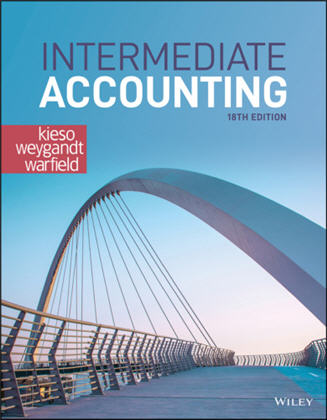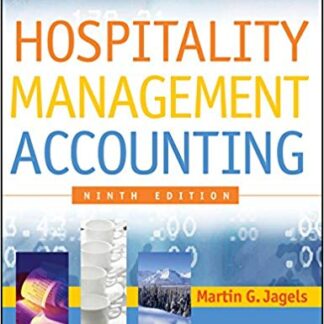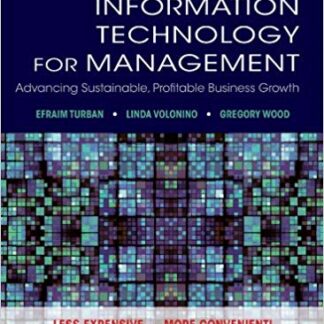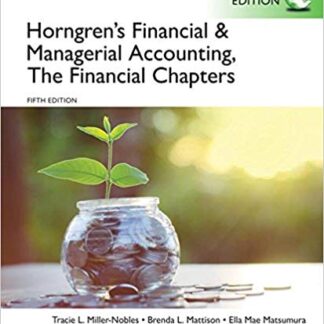Description
Intermediate Accounting 18th Edition by Donald E. Kieso, ISBN-13: 978-1119790976
[PDF eBook eTextbook] – Available Instantly
- Publisher: Wiley; 18th edition (April 26, 2022)
- Language: English
- 1616 pages
- ISBN-10: 1119790972
- ISBN-13: 978-1119790976
Intermediate Accounting by Donald Kieso, Jerry Weygandt, and Terry Warfield has always been, and continues to be, the gold standard. Through significant updates, the 18th Edition presents a refreshed, accessible, and modern approach with new perspectives that help connect students to the what, the why, and the how of accounting information.
Table of Contents:
Cover
Title Page
Copyright
Dedicated To
From the Authors
About the Authors
New to This Edition
Reimagined Pedagogy
Data Analytics
Engaging Online Student Resources and Tools
Student Assessment
Preparing for the CPA Exam
Acknowledgments
CHAPTER 0: Accounting Cycle Review
Accounting Transactions
Analyzing Transactions
Summary of Transactions
Debits and Credits
Debit and Credit Procedures
Revenues and Expenses
Stockholders’ Equity Relationships
Summary of Debit/Credit Rules
The Recording Process
The Journal
The Ledger
Chart of Accounts
Posting
The Recording Process Illustrated
Summary Illustration of Journalizing and Posting
Limitations of a Trial Balance
The Revenue Recognition Principle
The Expense Recognition Principle
Accrual Versus Cash Basis of Accounting
The Need for Adjusting Entries
Types of Adjusting Entries
Prepaid Expenses
Need for Adjustment
Unearned Revenues
Accrued Revenues
Accrued Expenses
Summary of Basic Relationships
Preparing the Adjusted Trial Balance
Preparing Financial Statements
Closing the Books
CHAPTER 1: The Environment and Conceptual Framework of Financial Reporting
Chapter Roadmap
1.1 Financial Reporting Environment
1.2 Conceptual Framework
1.3 Assumptions and Principles
1.4 Major Challenges in Financial Reporting
Review and Practice
Key Terms Review
Learning Objectives Review
Questions
Brief Exercises
Exercises
Using Your Judgment
Developing Your Professional Skills
Critical-Thinking Cases
IFRS Insights
CHAPTER 2: The Accounting Information System
Chapter Roadmap
2.1 Accounting Information System
2.2 Analyze and Record Business Transactions
2.3 Adjusting Entries
2.4 Preparing Financial Statements
2.5 Financial Statements for a Merchandising Company
APPENDIX 2A: Cash-Basis Accounting versus Accrual-Basis Accounting
APPENDIX 2B: Using Reversing Entries
APPENDIX 2C: Using a Worksheet: The Accounting Cycle Revisited
Review and Practice
Key Terms Review
Review of Basic Terminology
Learning Objectives Review
Questions
Brief Exercises
Exercises
Problems
Using Your Judgment
Developing Your Professional Skills
Analytics in Action Activities
IFRS Insights
CHAPTER 3: Income Statement, Related Information, and Revenue Recognition
Chapter Roadmap
3.1 Income Statement
3.2 Reporting Special Income Items
3.3 Stockholders’ Equity Statements
3.4 Revenue Recognition—The Fundamentals
3.5 Quality of Earnings
APPENDIX 3A: Accounting Changes and Errors
Review and Practice
Key Terms Review
Learning Objectives Review
Questions
Brief Exercises
Exercises
Problems
Using Your Judgment
Developing Your Professional Skills
Critical-Thinking Cases
Analytics in Action Activities
IFRS Insights
CHAPTER 4: Balance Sheet and Statement of Cash Flows
Chapter Roadmap
4.1 Balance Sheet
4.2 Statement of Cash Flows
APPENDIX 4A: Additional Information
APPENDIX 4B: Ratio Analysis—A Reference
Review and Practice
Key Terms Review
Learning Objectives Review
Questions
Brief Exercises
Exercises
Problems
Using Your Judgment
Developing Your Professional Skills
Critical-Thinking Cases
Analytics in Action Activities
IFRS Insights
CHAPTER 5: Accounting and the Time Value of Money
Chapter Roadmap
5.1 Basic Time Value Concepts
5.2 Single-Sum Problems
5.3 Annuities (Future Value)
5.4 Annuities (Present Value)
5.5 Other Time Value of Money Issues
APPENDIX 5A: Technology Tools for Time Value of Money Problems
Review and Practice
Key Terms Review
Learning Objectives Review
Questions
Brief Exercises
Exercises
Problems
Using Your Judgment
Developing Your Professional Skills
Analytics in Action Activities
CHAPTER 6: Cash and Receivables
Chapter Roadmap
6.1 Cash
6.2 Receivables
6.3 Valuation of Accounts Receivable
6.4 Notes Receivable
6.5 Other Issues
APPENDIX 6A: Cash Controls
APPENDIX 6B: Collectibility Assessment Based on Expected Cash Flows
Review and Practice
Key Terms Review
Learning Objectives Review
Questions
Brief Exercises
Exercises
Problems
Using Your Judgment
Developing Your Professional Skills
Critical-Thinking Cases
Analytics in Action Activities
IFRS Insights
CHAPTER 7: Valuation of Inventories: A Cost-Basis Approach
Chapter Roadmap
7.1 Inventory Issues
7.2 Goods and Costs Included in Inventory
7.3 Which Cost Flow Assumption to Adopt?
7.4 Special Issues Related to LIFO
7.5 Effect of Inventory Errors
Review and Practice
Key Terms Review
Learning Objectives Review
Questions
Brief Exercises
Exercises
Problems
Using Your Judgment
Developing Your Professional Skills
Critical-Thinking Cases
Analytics in Action Activities
CHAPTER 8: Inventories: Additional Valuation Issues
Chapter Roadmap
8.1 Lower-of-Cost-or-Net Realizable Value
8.2 Lower-of-Cost-or-Market
8.3 Other Valuation Approaches
8.4 The Gross Profit Method of Estimating Inventory
8.5 Retail Inventory Method
8.6 Presentation and Decision Analysis
APPENDIX 8A: LIFO Retail Methods
Review and Practice
Key Terms Review
Learning Objectives Review
Questions
Brief Exercises
Exercises
Problems
Using Your Judgment
Developing Your Professional Skills
Critical-Thinking Cases
Analytics in Action Activities
IFRS Insights
CHAPTER 9: Acquisition and Disposition of Property, Plant, and Equipment
Chapter Roadmap
9.1 Property, Plant, and Equipment
9.2 Interest Costs During Construction
9.3 Valuation of Property, Plant, and Equipment
9.4 Costs Subsequent to Acquisition
9.5 Disposition of Property, Plant, and Equipment
APPENDIX 9A: Accounting for Contributions
Review and Practice
Key Terms Review
Learning Objectives Review
Questions
Brief Exercises
Exercises
Problems
Using Your Judgment
Developing Your Professional Skills
Critical-Thinking Cases
Analytics in Action Activities
CHAPTER 10: Depreciation, Impairments, and Depletion
Chapter Roadmap
10.1 Depreciation—A Method of Cost Allocation
10.2 Impairments
10.3 Depletion
10.4 Presentation and Decision Analysis
APPENDIX 10A: Income Tax Depreciation
Review and Practice
Key Terms Review
Learning Objectives Review
Questions
Brief Exercises
Exercises
Problems
Using Your Judgment
Developing Your Professional Skills
Critical-Thinking Cases
Analytics in Action Activities
IFRS Insights
CHAPTER 11: Intangible Assets
Chapter Roadmap
11.1 Intangible Asset Issues
11.2 Types and Presentation of Intangible Assets
11.3 Goodwill
11.4 Research and Development Costs
Review and Practice
Key Terms Review
Learning Objectives Review
Questions
Brief Exercises
Exercises
Problems
Using Your Judgement
Developing Your Professional Skills
Critical-Thinking Cases
Analytics in Action Activities
IFRS Insights
CHAPTER 12: Current Liabilities and Contingencies
Chapter Roadmap
12.1 Current Liabilities
12.2 Unearned Revenues
12.3 Contingencies
12.4 Presentation and Decision Analysis
Review and Practice
Key Terms Review
Learning Objectives Review
Questions
Brief Exercises
Exercises
Problems
Using Your Judgment
Developing Your Professional Skills
Critical-Thinking Cases
Analytics in Action Activities
IFRS Insights
CHAPTER 13: Long-Term Liabilities
Chapter Roadmap
13.1 Bonds Payable
13.2 Extinguishment of Debt
13.3 Long-Term Notes Payable
13.4 Reporting and Analyzing Liabilities
APPENDIX 13A: Troubled-Debt Restructuring
Review and Practice
Key Terms Review
Learning Objectives Review
Questions
Brief Exercises
Exercises
Problems
Using Your Judgment
Developing Your Professional Skills
Critical-Thinking Cases
Analytics in Action Activities
IFRS Insights
CHAPTER 14: Stockholders’ Equity
Chapter Roadmap
14.1 Corporate Capital
14.2 Reacquisition of Shares
14.3 Dividend Policy
14.4 Presentation and Decision Analysis of Stockholders’ Equity
APPENDIX 14A: Dividend Preferences and Book Value per Share
Review and Practice
Key Terms Review
Learning Objectives Review
Questions
Brief Exercises
Exercises
Problems
Using Your Judgment
Developing Your Professional Skills
Critical-Thinking Cases
Analytics in Action Activities
IFRS Insights
CHAPTER 15: Dilutive Securities and Earnings per Share
Chapter Roadmap
15.1 Dilutive Securities
15.2 Stock Warrants
15.3 Stock Compensation Plans
15.4 Basic Earnings per Share
15.5 Diluted Earnings per Share
APPENDIX 15A: Accounting for Stock-Appreciation Rights
APPENDIX 15B: Comprehensive Earnings per Share Example
Review and Practice
Key Terms Review
Learning Objectives Review
Questions
Brief Exercises
Exercises
Problems
Using Your Judgment
Developing Your Professional Skills
Critical-Thinking Cases
Analytics in Action Activities
IFRS Insights
CHAPTER 16: Investments
Chapter Roadmap
16.1 Investments in Debt Securities
16.2 Investments in Equity Securities
16.3 Equity and Consolidation Methods
16.4 Other Financial Reporting Issues
APPENDIX 16A: Accounting for Derivative Instruments
APPENDIX 16B: Fair Value Disclosures
Review and Practice
Key Terms Review
Learning Objectives Review
Questions
Brief Exercises
Exercises
Problems
Using Your Judgment
Developing Your Professional Skills
Critical-Thinking Cases
Analytics in Action Activities
IFRS Insights
CHAPTER 17: Revenue Recognition
Chapter Roadmap
17.1 Fundamentals of Revenue Recognition
17.2 The Five-Step Process Revisited
17.3 Accounting for Revenue Recognition Issues
17.4 Presentation and Disclosure
APPENDIX 17A: Long-Term Construction Contracts
APPENDIX 17B: Revenue Recognition for Franchises
Review and Practice
Key Terms Review
Learning Objectives Review
Questions
Brief Exercises
Exercises
Problems
Using Your Judgment
Developing Your Professional Skills
Critical-Thinking Cases
Analytics in Action Activities
CHAPTER 18: Accounting for Income Taxes
Chapter Roadmap
18.1 Fundamentals of Accounting for Income Taxes
18.2 Additional Considerations
18.3 Accounting for Net Operating Losses
18.4 Financial Statement Presentation
APPENDIX 18A: Comprehensive Example of Interperiod Tax Allocation
APPENDIX 18B: Accounting for Net Operating Loss Carrybacks
Review and Practice
Key Terms Review
Learning Objectives Review
Questions
Brief Exercises
Exercises
Problems
Using Your Judgment
Developing Your Professional Skills
Critical-Thinking Cases
Analytics in Action Activities
IFRS Insights
CHAPTER 19: Accounting for Pensions and Postretirement Benefits
Chapter Roadmap
19.1 Fundamentals of Pension Plan Accounting
19.2 Using a Pension Worksheet
19.3 Prior Service Cost (PSC)
19.4 Gains and Losses
19.5 Reporting Pension Plans in Financial Statements
APPENDIX 19A: Accounting for Postretirement Benefits
Review and Practice
Key Terms Review
Learning Objectives Review
Questions
Brief Exercises
Exercises
Problems
Using Your Judgment
Developing Your Professional Skills
Critical-Thinking Cases
Analytics in Action Activities
IFRS Insights
CHAPTER 20: Accounting for Leases
Chapter Roadmap
20.1 The Leasing Environment
20.2 Accounting for Finance Leases
20.3 Accounting for Operating Leases
20.4 Special Lease Accounting Problems
APPENDIX 20A: Sale-Leasebacks
APPENDIX 20B: Direct Financing Lease (Lessor)
Review and Practice
Key Terms Review
Learning Objectives Review
Questions
Brief Exercises
Exercises
Problems
Using Your Judgment
Developing Your Professional Skills
Critical-Thinking Cases
Analytics in Action Activities
IFRS Insights
CHAPTER 21: Accounting Changes and Error Analysis
Chapter Roadmap
21.1 Accounting Changes
21.2 Other Accounting Changes
21.3 Accounting Errors
21.4 Error Analysis
APPENDIX 21A: Changing from or to the Equity Method
Review and Practice
Key Terms Review
Learning Objectives Review
Questions
Brief Exercises
Exercises
Problems
Using Your Judgment
Developing Your Professional Skills
Critical-Thinking Cases
Analytics in Action Activities
IFRS Insights
CHAPTER 22: Statement of Cash Flows
Chapter Roadmap
22.1 Overview of Statement of Cash Flows
22.2 Preparing the Statement of Cash Flows
22.3 Net Cash Flow from Operating Activities—Direct Method
22.4 Special Problems in Statement Preparation
22.5 Use of a Worksheet
Review and Practice
Key Terms Review
Learning Objectives Review
Questions
Brief Exercises
Exercises
Problems
Using Your Judgment
Developing Your Professional Skills
Critical-Thinking Cases
Analytics in Action Activities
IFRS Insights
CHAPTER 23: Full Disclosure in Financial Reporting
Chapter Roadmap
23.1 Full Disclosure Principle
23.2 Disclosure Issues
23.3 Auditor’s and Management’s Reports
23.4 Current Reporting Issues
APPENDIX 23A: Basic Financial Statement Analysis
Review and Practice
Key Terms Review
Learning Objectives Review
Questions
Brief Exercises
Exercises
Problems
Using Your Judgment
Developing Your Professional Skills
Critical-Thinking Cases
Analytics in Action Activities
IFRS Insights
Appendix A: Private Company Accounting
A.1 The Private Company Council (PCC)
A.2 Private Company Alternatives for Intangible Assets and Goodwill
A.3 Summary
Appendix B: Specimen Financial Statements: The Procter & Gamble Company
Appendix C: Specimen Financial Statements: The Coca-Cola Company
Appendix D: Specimen Financial Statements: PepsiCo, Inc.
Company Index
Subject Index
Intermediate Accounting 18E: List of Accounts
Notes
End User License Agreement
DONALD E. KIESO, PhD, CPA, received his bachelor’s degree from Aurora University and his doctorate in accounting from the University of Illinois. He has served as chairman of the Department of Accountancy and is currently the KPMG Emeritus Professor of Accountancy at Northern Illinois University.
JERRY J. WEYGANDT, PhD, CPA, is the Arthur Andersen Alumni Emeritus Professor of Accounting at the University of Wisconsin―Madison. He holds a Ph.D. in accounting from the University of Illinois. Articles by Professor Weygandt have appeared in the Accounting Review, Journal of Accounting Research, Accounting Horizons, Journal of Accountancy, and other academic and professional journals.
TERRY D. WARFIELD, PhD, is the PwC Chair in Accounting at the University of Wisconsin―Madison. He received a B.S. and M.B.A. from Indiana University and a Ph.D. in accounting from the University of Iowa.
What makes us different?
• Instant Download
• Always Competitive Pricing
• 100% Privacy
• FREE Sample Available
• 24-7 LIVE Customer Support




